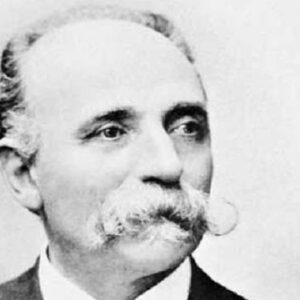Camillo Golgi was an Italian doctor, biologist, and pathologist. In 1906, he and the Spanish histologist Santiago Ramón y Cajal shared the Nobel Prize for Physiology or Medicine. This man is thought to be the best neuroscientist of the 1800s. Several anatomical and physiological things are named after him. Golgi, using only simple tools, came up with the silver nitrate method for studying nerve tissues. This helped find a nerve cell with a lot of nerve extensions called dendrites. This is now called a “Golgi cell,” after Camillo Golgi, who found it. This finding backed up the work of German anatomist Wilhelm von Waldeyer-Hartz and Spanish scientist Ramón y Cajal. They went on to show that nerve cells are the basic building blocks of the entire nervous system. This turned out to be a big step forward for modern neuroscience. Later, his research led to the discovery of the “Golgi tendon spindle” or “Golgi tendon organ” and the “Golgi complex” or “Golgi apparatus.” Camillo Golgi also looked into what causes malaria. He found that the third and fourth types of malarial fever are caused by a parasite called Plasmodium. He was a well-known teacher, and every young researcher was welcome in his lab.
Early years and childhood
Camillo Golgi was born on July 7, 1843, in the northern Italian village of Corteno, which is in the province of Brescia (Lombardy). After his name, the village is now called Corteno Golgi. His father was a doctor and the Brescia district medical officer.
He went to the University of Pavia to study medicine. Cesare Lombroso was in charge of the Institute of Psychiatry, where he worked as an intern.
Golgi became interested in experimental research and histological techniques while working in the laboratory of experimental pathology of histology and pathology professor Giulio Bizzozero.
He got his degree from the University of Pavia in 1865. He was a student when Italy was fighting for its independence.
Camillo Golgi’s Career
After he got his degree, he did more research at the Hospital of St. Matteo in Pavia. During this time, he mostly looked into the nervous system in his research.
In 1872, he had to stop his academic research and take a job as the chief medical officer at the Hospital of Chronically Ill in Abbiategrasso. Golgi started his experiments by staining nervous tissue with mostly silver in a small kitchen lab.
In 1873, he wrote a short note in which he talked about what he had seen in the parts of the nervous tissue. The name of the note was “On the structure of the gray matter of the brain,” and it was published in the “Gazzetta Medica Italiana.”
In an article about the olfactory bulbs in 1875, Golgi published the first drawings of the structures of the brain that the “Golgi stain” showed.
Golgi found the sensory cells in tendons in 1878. These cells are now called Golgi tendon organs.
In 1885, a book with pictures came out about the exact anatomy of the central nervous organs. He went back to Pavia the same year. In 1876, he became a professor at the school he had gone to.
In 1881, he was given a job at the University of Pavia as the chair of General Pathology.
From 1886 to 1892, Golgi made important contributions to the study of by describing in detail the life cycle of Plasmodium and the way that repeated fever and the release of the parasite from the red cells happened at the same time.
Golgi found the structure of neutrons inside cells in 1897. This structure is called the Golgi apparatus after him.
Camillo Golgi was made a senator by King Umberto I in the year 1900.
In 1913, he joined the Royal Netherlands Academy of Arts and Sciences as a member from outside the country.
Even though he stopped working in 1918, he was still a professor at the University of Pavia.
Works of note
Camillo Golgi’s most important work was finding the “black reaction” or “reazione nera” (later called “Golgi’s stain”), which uses silver nitrate to stain nerve cells. Because of what happened next, he was able to see for the first time how nerve cells move through the brain.
He also found the Golgi apparatus, which was a big step forward in cell biology and made him the most-cited scientist in cytology. In the mid-1950s, the electron microscope was used to prove that it really did exist. The Golgi apparatus is a key part of how proteins are sorted, moved, and sent to specific places inside cells.
Awards & Achievements
In 1906, Golgi and Santiago Ramón y Cajal shared the Nobel Prize for Physiology for their work on the structure of the nervous system.
Personal History and Legacies
In 1877, he married Lina Aletti, the niece of Giulio Bizzozero. The couple didn’t have any kids, so they took in Golgi’s niece Carolina (now Mrs. Carolina Golgi-Papini).
Opera Omnia, which came out in four volumes, is a collection of all of his works (the first three in 1903, the fourth volume in 1929).
Camillo Golgi died on January 21, 1926, in Pavia, Italy, and was laid to rest in the Monumental Cemetery of Pavia (Viale San Giovannino).
In a yard of the old buildings of the University of Pavia, there is a statue of him made of marble.Golgi has his own room in the Historical Museum at the University of Pavia, where his honorary degrees, diplomas, and other awards are kept.
Estimated Net worth
Camillo is one of the wealthiest and most well-known Physiologist. Based on what we’ve found on Wikipedia, Forbes, and Business Insider, Camillo Golgi’s net worth is about $1.5 million.
Trivia
In Golgi’s lab, Adelchi Negri found the Negri bodies and Emilio Veratti first thought of sarcoplasmic reticulum in skeletal muscle fibers.


